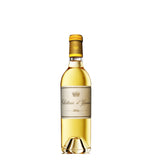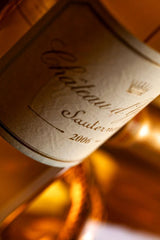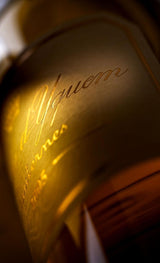- CRITICAL REVIEWS
- WINEMAKER NOTES
Robert Parker Wine Advocate
Vinous
2016 Chateau d'Yquem, Sauternes, France
Viticulture: Fertilizer is exclusively organic and used sparingly; only 20 hectares are fertilized per year. This compost maintains the soil’s natural equilibrium while keeping it from becoming too rich or fertile, as this would prevent the vines from producing wines of character. Chemical weed killers are never used. The soil undergoes regular cycles of manual work: earthing up twice a year, unearthing twice a year, and countless other vineyard operations. The vines are severely pruned in early winter to limit yields and encourage maximum ripeness. Château d’Yquem’s 20 female vineyard workers are each assigned specific plots, so they become familiar with virtually each vine. Among other duties, they are responsible for green pruning operations such as bud pruning as well as tying up and removing side shoots. The final touch before the vintage is leaf thinning on the eastern side of some 700,000 vines so the grapes dry more quickly in the morning while continuing to protect the western side most exposed to rain.
Harvest: Château d’Yquem’s goal is to obtain musts with 20° potential alcohol (360 grams of sugar per liter). It is a daring gamble to obtain such concentration naturally, implying a long wait with the very real risk that the entire harvest may be lost as winter approaches. An increase from 18 to 20° alcohol decreases the volume of juice by an average of 50%. This largely accounts for Yquem’s extraordinarily low yields (9 hectoliters per hectare on average). Grapes have been harvested the same way at Château d’Yquem for centuries. The pickers scour the entire vineyard for grapes that are both botrytised and have attained maximum concentration. There are an average of 5 or 6 passes per vintage, spread over 6 weeks.
Vinification: It takes no more than 1 hour for grapes picked at Château d’Yquem to arrive at the cellar. Pressing takes into account the texture and fragility of the fruit. The grapes are pressed 3 or 4 times at Yquem. As opposed to other white wines, the sugar content and quality increase with each pressing. The first pressing in a pneumatic wine press produces 75% of the total juice, with about 19° potential alcohol. The second yields 15% of the total juice, with about 21° potential alcohol, while the third can reach up to 25°. The hard cake of pomace is then broken up, destemmed, and put through a low-capacity vertical press. Wines from the various pressings are blended before barrel fermentation. Unusually in Sauternes, fermentation at Yquem takes place in barrel to maintain maximum control over this most delicate and mysterious part of winemaking. Only new barrels are used each year. These are made with the finest stave oak from forests in the eastern part of central France. Each individual barrel is closely monitored, and the château’s in-house laboratory carries out regular analyses. The most active musts finish fermenting in just two weeks. However, others can take up to six weeks. Fermentation stops naturally in all instances. The alcohol content at Château d’Yquem varies from 12.5° to 14.5° according to the sugar content of the must. The ideal figure is 13.5° with 120 to 150 g/l of g/l of residual sugar.
Aging: Wine made from grapes picked on the same day is aged separately for 6 to 8 months. A preliminary blend is made from selected batches in the spring following the harvest. After taste tests and laboratory analyses, wines not up to the château’s strict standards are set aside. The barrels that have been retained are then moved to the aging cellar where they will stay for 20 months. Every barrel is topped up twice a week. This consists of adding wine to fill up the airspace created by evaporation at the top of the barrel. Furthermore, every barrel is racked 15 times to remove heavy lees. Light sediment in suspension is removed by a process called fining. The rigorous selection process continues in the cellar. Towards the end of barrel aging, a rigorous selection takes place at blind tastings. This will determine the final blend of Château d’Yquem.
Bottling: The wine is bottled during the third winter after the harvest, under the best possible technical conditions using 54 mm corks, the only length suitable for a wine of such great aging potential. Once the wine is bottled, it is then labelled. The capsule and label match the wine’s color. Bottles are then wrapped in white silk paper and delicately put into wooden cases. These are stamped with the château coat of arms, sealed, and ready to be shipped and age in the cellars of wine lovers around the world.
Tasting Notes: Yquem tells a unique story… It starts with the bouquet. Although not always very outgoing in young vintages, it is marked by fruit (apricot, mandarin, and occasionally tropical fruit) and oak (vanilla and toasty aromas). Older vintages, on the other hand, have an extraordinarily complex fragrance as soon as the bottle is opened, with hints of dried fruit (dried apricot, prune, stewed fruit, and marmalade), spice (cinnamon, saffron, and liquorice), and even flowers (lime blossom, etc.). The first impression of Château d’Yquem on the palate is always very silky, and often sumptuous. It then fills out, “coating the palate”. This fine wine has a strong, but never overbearing character, with great elegance and poise. It always maintains a balance between sugar and acidity (sweetness and freshness). A touch of bitterness can also contribute to the overall harmony. Château d’Yquem’s aftertaste is legendary, and it tells another story, which lasts and lasts…
Serving Suggestions: Certain connoisseurs consider it outrageous to drink a young Yquem and believe that opening such a monumental wine before its thirtieth birthday is tantamount to a sacrilege. Others, on the contrary, think that Yquem can be enjoyed at all stages in its life.





















